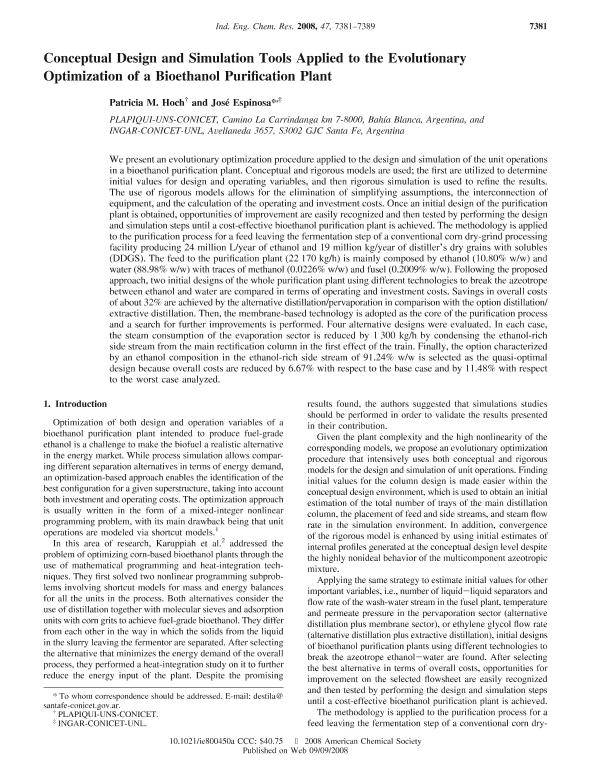Artículo
Conceptual design and simulation tools applied to the evolutionary optimization of a bioethanol purification plant
Fecha de publicación:
10/2008
Editorial:
American Chemical Society
Revista:
Industrial & Engineering Chemical Research
ISSN:
0888-5885
Idioma:
Inglés
Tipo de recurso:
Artículo publicado
Clasificación temática:
Resumen
We present an evolutionary optimization procedure applied to the design and simulation of the unit operations in a bioethanol purification plant. Conceptual and rigorous models are used; the first are utilized to determine initial values for design and operating variables, and then rigorous simulation is used to refine the results. The use of rigorous models allows for the elimination of simplifying assumptions, the interconnection of equipment, and the calculation of the operating and investment costs. Once an initial design of the purification plant is obtained, opportunities of improvement are easily recognized and then tested by performing the design and simulation steps until a cost-effective bioethanol purification plant is achieved. The methodology is applied to the purification process for a feed leaving the fermentation step of a conventional corn dry-grind processing facility producing 24 million L/year of ethanol and 19 million kg/year of distiller's dry grains with solubles (DDGS). The feed to the purification plant (22 170 kg/h) is mainly composed by ethanol (10.80% w/w) and water (88.98% w/w) with traces of methanol (0.0226% w/w) and fusel (0.2009% w/w). Following the proposed approach, two initial designs of the whole purification plant using different technologies to break the azeotrope between ethanol and water are compared in terms of operating and investment costs. Savings in overall costs of about 32% are achieved by the alternative distillation/pervaporation in comparison with the option distillation/extractive distillation. Then, the membrane-based technology is adopted as the core of the purification process and a search for further improvements is performed. Four alternative designs were evaluated. In each case, the steam consumption of the evaporation sector is reduced by 1 300 kg/h by condensing the ethanol-rich side stream from the main rectification column in the first effect of the train. Finally, the option characterized by an ethanol composition in the ethanol-rich side stream of 91.24% w/w is selected as the quasi-optimal design because overall costs are reduced by 6.67% with respect to the base case and by 11.48% with respect to the worst case analyzed.
Palabras clave:
Bioethanol
,
Conceptual Design
,
Simulation
,
Optimization
Archivos asociados
Licencia
Identificadores
Colecciones
Articulos(INGAR)
Articulos de INST.DE DESARROLLO Y DISEÑO (I)
Articulos de INST.DE DESARROLLO Y DISEÑO (I)
Articulos(PLAPIQUI)
Articulos de PLANTA PILOTO DE INGENIERIA QUIMICA (I)
Articulos de PLANTA PILOTO DE INGENIERIA QUIMICA (I)
Citación
Hoch, Patricia Monica; Espinosa, Hector Jose Maria; Conceptual design and simulation tools applied to the evolutionary optimization of a bioethanol purification plant; American Chemical Society; Industrial & Engineering Chemical Research; 47; 19; 10-2008; 7381-7389
Compartir
Altmétricas




